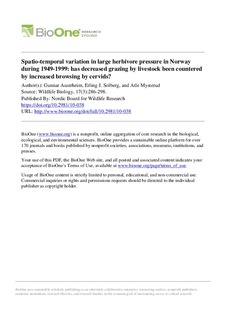| dc.contributor.author | Austrheim, Gunnar | |
| dc.contributor.author | Solberg, Erling Johan | |
| dc.contributor.author | Mysterud, Atle | |
| dc.date.accessioned | 2017-11-29T13:42:25Z | |
| dc.date.available | 2017-11-29T13:42:25Z | |
| dc.date.created | 2011-12-15T09:07:04Z | |
| dc.date.issued | 2011 | |
| dc.identifier.citation | Wildlife Biology. 2011, 17 (3), 286-298. | nb_NO |
| dc.identifier.issn | 0909-6396 | |
| dc.identifier.uri | http://hdl.handle.net/11250/2468549 | |
| dc.description.abstract | During recent decades, rough livestock grazing has decreased markedly on unimproved land (i.e. natural and seminatural habitats) across most of Europe, whilst the number of wild cervids has increased. However, we still know little about the overall changes in the herbivore pressure and how herbivore regimes vary between biogeographic regions.We have quantified the spatio-temporal variation in herbivore pressure indirectly by estimating the metabolic biomass of large herbivores in mountain, coastal and inland municipalities of Norway every 10th year during 1949-1999. We quantified how much livestock biomass has decreased, whether this corresponded to increasing cervid biomass, and whether the proportion of grazing relative to browsing has changed within the herbivore community. Total metabolic biomass of livestock and cervids (MBAtotal) decreased from 126 kg/km2 in 1949 to 107 kg/km2 in 1999 (;85% of MBAtotal in 1949). Changes differed markedly between regions. Herbivore pressure in the coastal region nearly halved from 1949 to 1999, while the decrease was minor in the inland and mountain regions. Livestock grazing more than halved, whereas the metabolic biomass of cervids increased by 276% from 1949 to 1999. Cervids dominated the community of large herbivores on unimproved land in Norway in 1999 (54% of MBAtotal). Livestock dominated in the mountain (52% ofMBAtotal) and in the coastal region (54% ofMBAtotal) in 1999, while cervids dominated in the inland region (67% of MBAtotal). Most herbivore foraging consisted of grazing in 1949 (89% at a national scale). This proportion was reduced to 54% by 1999. Percent browsing was especially high (. 90%) in several municipalities in southeastern Norway in 1999. The increase of wild cervids is exceptional in a historical perspective, and managers have to adapt to wild cervids being the major ecosystem engineers in many landscapes. | nb_NO |
| dc.language.iso | eng | nb_NO |
| dc.publisher | Nordic Board for Wildlife Research (NKV) | nb_NO |
| dc.rights | Navngivelse 4.0 Internasjonal | * |
| dc.rights.uri | http://creativecommons.org/licenses/by/4.0/deed.no | * |
| dc.title | Spatio-temporal variation in large herbivore pressure in Norway during 1949-1999: has decreased grazing by livestock been countered by increased browsing by cervids? | nb_NO |
| dc.type | Journal article | nb_NO |
| dc.type | Peer reviewed | nb_NO |
| dc.description.version | publishedVersion | nb_NO |
| dc.source.pagenumber | 286-298 | nb_NO |
| dc.source.volume | 17 | nb_NO |
| dc.source.journal | Wildlife Biology | nb_NO |
| dc.source.issue | 3 | nb_NO |
| dc.identifier.doi | 10.2981/10-038 | |
| dc.identifier.cristin | 868273 | |
| dc.relation.project | Norges forskningsråd: 179569 | nb_NO |
| dc.description.localcode | © Wildlife Biology, NKV. Wildlife Biology is published under a CC-BY license and is immediately available for anyone free of charge. | nb_NO |
| cristin.unitcode | 194,31,10,0 | |
| cristin.unitname | Institutt for naturhistorie | |
| cristin.ispublished | true | |
| cristin.fulltext | original | |
| cristin.qualitycode | 1 | |

